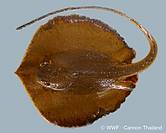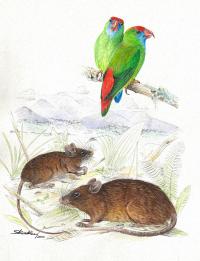New Asian Species
Posted by: Loren Coleman on April 25th, 2006
More species are being found, anew, in south Asia. We can hardly keep up with the announcements. Here’s a quick overview with some photos and links to the source articles.
A new species of freshwater stringray (pictured here) has been discovered in Thailand.
One of the discoveries was the remarkable Himanturan kittipongi, a new species of freshwater stringray from Thailand.

Meanwhile, in Laos, six new species of frogs have been found. One is shown. Laos is the least densely populated country in Asia and has produced a treasure trove of wildlife discoveries during recent years.
Rana khalam is one of six new species of frog found in Laos.

For more on the two new species found in the Philippines pictured below, see “New Mouse and Parrot Discovered”.

About Loren Coleman
Loren Coleman is one of the world’s leading cryptozoologists, some say “the” leading living cryptozoologist. Certainly, he is acknowledged as the current living American researcher and writer who has most popularized cryptozoology in the late 20th and early 21st centuries.
Starting his fieldwork and investigations in 1960, after traveling and trekking extensively in pursuit of cryptozoological mysteries, Coleman began writing to share his experiences in 1969. An honorary member of Ivan T. Sanderson’s Society for the Investigation of the Unexplained in the 1970s, Coleman has been bestowed with similar honorary memberships of the North Idaho College Cryptozoology Club in 1983, and in subsequent years, that of the British Columbia Scientific Cryptozoology Club, CryptoSafari International, and other international organizations. He was also a Life Member and Benefactor of the International Society of Cryptozoology (now-defunct).
Loren Coleman’s daily blog, as a member of the Cryptomundo Team, served as an ongoing avenue of communication for the ever-growing body of cryptozoo news from 2005 through 2013. He returned as an infrequent contributor beginning Halloween week of 2015.
Coleman is the founder in 2003, and current director of the International Cryptozoology Museum in Portland, Maine.










New frogs and fish may not be as “sexy” as large cryptids, but this is exactly the kind of evidence that Penn & Teller (and other dismissive types) should be presented with when trying to discredit cryptozoology.
Plus we should never forget that the mountain gorilla was unknown to science (a cryptid) until 1902. The okapi, too, was unknown until 1901. The king cheetah (now known to be a mutation, rather than a seperate species) was still a “cryptid” until photographed in the late 70s, despite reports and even specimens, in the form of skins, going back 50 years (on another subject, the dismissal of the king cheetah, even when skins were presented, reinforces the arguments of those who are opposed to “shooting” cryptids to prove their existence.)
All of these are now known animals, or known variants.
But for years reported sightings were dismissed as mistaken identity or simply entertaining “traveler’s tales”.
These facts should be in every cryptozoologists repertoire when forced to confront the dismissive, and, having not seen the show, I’m curious if such issues were raised with P&T.
Good point, Jeremy, about this being “exactly the type of evidence”. In addition, I think people forget that for the more “popular” cryptids such as lake monsters and bigfoots, we are in all likelihood trying to learn about a “real” animal.
That sounds like hardly a point worth making, but I think it’s easy for people to think that cryptozoologists are concerned with exploring the twilight zone – we tend to forget (or the perception is that we tend to forget) that we’re talking about “normal”, “plain old” animals.
By the way, the stingray photo doesn’t do its size justice – it’s two foot across.
Also – let’s not forget the new Philippines parrot and mouse which were also announced on Cryptomundo.
Just wanted to make everyone aware of a new species of Polypterus.It’s a fish…just so you know…African to be exact…
Polypterus mokelembembe…at least a few scientists are with us it seems!
Thanks Nozzgoblin – always appreciate fish info!
Check out Polypterus mokelembembe.
I am very aware of the new Polypterid, and am eager to see more on it…and although the cryptid species name is amusing, it is poor taxonomy, especially when we are moving toward more descriptive binomials these days.
Channallabes apus, another interesting catfish that hunts terrestrial insects! Not sure how new the species is to science is mind, but a new and major discovery, in terms of evolution.
Toirtis, At least this nomenclature has some meaning unlike the countless coleoptera and Orchid bearing the name of those who “discovered” it! Imagine, Bigfoot or Homo Smithian!
Hmmmm, looking back at the Camiguin posting, and reflecting on the “too shoot/not to shoot” discussions that we have had, it seems that, even despite island residents being familiar with the bird from the PET trade (which means some collectors must have known of it) without the skins of specimens collected in the 1960s physical observations would have been dismissed.
As noted previously, I’m an avid hunter, but normally come down on the side of those opposed to killing cryptids to prove their existence. (“Don’t kill it if you ain’t gonna eat it,” as my Dad always said.)
However, the Camiguin case raises some serious questions about this.
Maybe more important than the question, “Is it OK to shoot an unknown animal?” is the question, “Why is science so reluctant to accept evidence?”
– Reluctantly I feel the myth and hype around many cryptids doesn’t help. Obviously many creatures have been described by science without dead specimens. Granted many may be very accessible to study observe or collect whilst alive, but I think much of it comes down to simple credibility. If an anuran expert goes into the Congo and claims to have found a new frog no questions are asked because little is known or considered by the lay person about the likely hood of a discovery like this. To find a hominid or a living dinosaur in a lake would face issues of a) The centuries old debate of is there isn’t their evidence that has many small minds already convinced one way or another. And b) the person who discovered it immediately discredited as a crack pot, and non-scientific for even looking in the first place! The unfortunate answer therefore is either to present a genuine body, or grasp some genuine scientific specifically ecological, biological weight and credibility to the cause. This may mean taking a hard-line stance on blurry pictures and suspect videos.
There is little or no reward apart from self satisfaction in finding frogs and fish. There is both fame fortune and or at worst world wide notoriety in simply making a solid claim to have witnessed or sighted let alone found a cryptid.
Tell that to all of the herpetologists and ichthyologists out there…
The “little or no reward” comment is accurate in terms of money and media attention. However, small species often make large contributions to science, filling in gaps in taxonomic relationships or demonstrating hitherto unknown features or behavior. The coelacanth would not have made nearly as much of a media splash had it been 30 cm long, but it would have been just as important, scientifically.
Matt Bille
Yeah. Wallabies are a dime a dozen, but someone had to do the unrewarding task of researching them.
Of all things they found a compound in their milk which is 100 times more effective than penicillin.
Who was the bloke who discovered penicillin in the first place? Oh, I can’t remember – he’s not that famous. I mean, he studied completely uninspiring bacteria! Nothing as fancy as even a fish!
And I doubt anyone’s made a fortune out of that penicillin stuff either…
Sorry, couldn’t help myself 😀
Thanks Ranatemporaria for the fish link. If you want to check out some not-so-new but oh-so-funky fish out of water, try themudskipper.org
The homepage scrolls through some fantastic photos, but it uses Flash Player. If you don’t have that, then click on the “Sitemap” button and spend 5 minutes checking out the links and photos.
Oh, and PS – I replied to your fish/frog comment a little out of context; sorry.
As far as the anurian expert going into the Congo and claiming a new species….that species is not accepted or described based soley on a single herpetologist’s account/description, although should he bring out with him photos, measurements, etc (and usually at least one specimen), that is another matter.
I am both a herpetologist and occasional amateur cryptozoologist, and although I would love to be believed on a new species based on a personal eyewitness, I would never expect anything more than mild interest from my colleages without some real evidence and data.
I totally agree, to find a new species of anything, myself would be a personal highlight of my life! However that’s speaking as an Ecologist/Freshwater biologist. For the many out there with but a fleeting biological interest there is certainly a quite ulterior and sinister motive in finding Bigfoot for example! Please don’t get me wrong, I fully understand the value and get particularly excited when any species are found, especially frogs and fish!
Youcantry…, thanks for the mudskipper link! I have kept skippers in vivariums at home for a while now, and have worked on various projects to breed them in captivity with varying success!